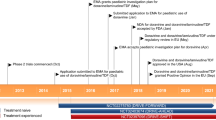Abstract
Aim: This review surveys the different classes of drugs.
Method: We searched electronic databases and selected articles about pharmacotherapy with anti-retroviral drugs.
Results: We discuss anti-retroviral drugs: the nucleotide reverse transcriptase inhibitors (NRTIs), the non-nucleoside reverse transcriptase inhibitors (NNRTIs), and the protease inhibitors (PIs). The combination of a PI and two NRTIs is very effective and lowers the viral load to below the limit of detection. However, it is not yet possible to eliminate the virus completely. Recently, the first member of a brand new class of drugs has become available, the fusion inhibitor enfuvirtide. We also discuss the problems associated with combining anti-retroviral drugs, such as compliance, resistance and serious side effects.
Discussion. It is important to investigate new combinations with new classes of drugs, like the fusion inhibitors, for better effectiveness and fewer side effects.
Similar content being viewed by others
References
Borleff JCC, Danner SA, Lange JMA, van Everdingen JJE. CBO richtlijn antiretrovirale behandeling in Nederland. [CBO guidelines: anti-retroviral treatment in the Netherlands.] Ned Tijdschr Geneesk 2001; 136: 1585–9.
Gallant JE. Initial therapy of HIV infections. J Clin Virol 2002; 25: 317–33.
Chapman T, McGavin J, Noble S. Tenofovir disoproxil fumarate. Drugs 2003; 63: 1597–608.
Moyle G. Stopping HIV fusion with enfuvirtide: the first step to extracellular HAART. J Antimicrob Chem 2003; 51: 213–17.
de Maat MM, Ekhart GC, Huitema AD, Koks CH, Mulder JW, Beynen JH. Drug interactions between antiretroviral drugs and comedicated agents. Clin Pharmacokinet 2003; 42: 223–83
Hansten PD, Horn JR. Hansten and Horn's interactions analysis and management. Edmonds, Washington: H&H Publications, 1999.
Drechsler H, Powderly WG. Switching effective antiretroviral therapy: a review. Clin Infect Dis 2002; 35: 1219–30.
Deeks SG, Wrin T, Lieger T, Hoh R, Hayden M, Helmm NS et al. Virological and immunological consequences of discontinuing combination antiretroviral-drug therapy in HIV-infected patients with detectable viremia. N Engl J Med 2001; 344: 472–80.
Aarnoutse RE, Schapiro JM, Boucher CAB, Hekster YA, Burger DM. Therapeutic drug monitoring an aid to optimizing response to antiretroviral drugs? Drugs 2003; 63: 741–53.
Author information
Authors and Affiliations
Rights and permissions
About this article
Cite this article
Stolk, L.M., Lüers, J.F. Increasing number of anti-HIV drugs but no definite cure Review of anti-HIV drugs. Pharm World Sci 26, 133–136 (2004). https://doi.org/10.1023/B:PHAR.0000026815.44214.83
Issue Date:
DOI: https://doi.org/10.1023/B:PHAR.0000026815.44214.83



